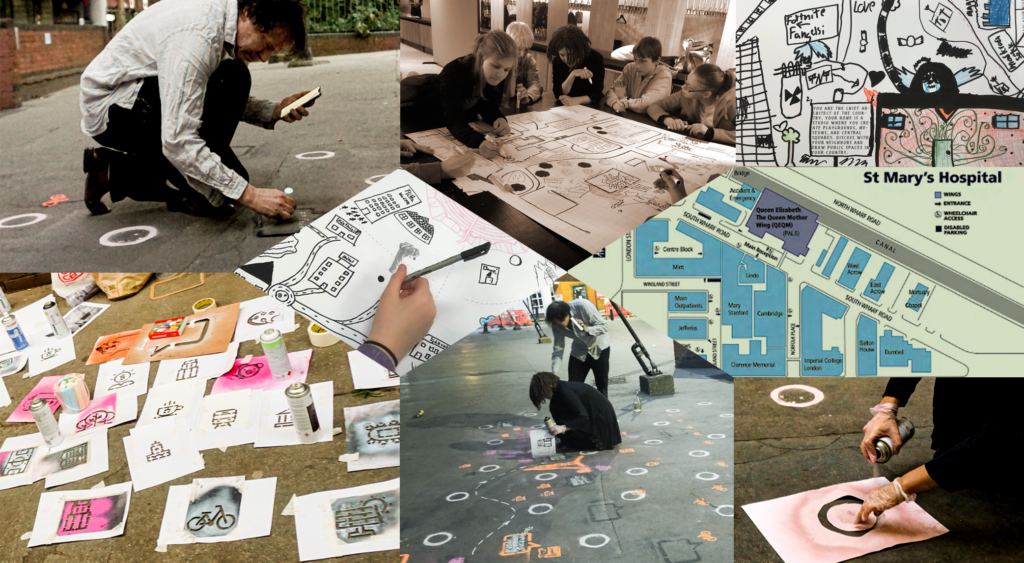We are inviting health workers, patients, service users – especially those employed and served by the NHS – to reimagine the health care spaces they work in, live in, heal in. We welcome all workers, from cleaners, porters, café staff, cooks, to nurses, doctors and managers as well as any patients.
Session 1: Planning meeting:
6pm, Thursday 18th June 2020 :
Zoom link: https://zoom.us/j/74314758176
(Meeting ID: 743 1475 8176 ) Password: CARE
Session 2: Visual Assembly at Our NHS Deserves Better: NHS Anniversary weekend:
Morning time tbc Saturday 4th July 2020 : Zoom link to follow

What: WHAT IF WE COULD OCCUPY THE HOSPITAL AND TURN IT INTO A MODEL HEALING SPACE? (a visual assembly exercise).
Planning session:
This is an invitation to plan the first part of a Visual Assembly, which is itself rather a new concept which we would like to explain. But first: Many complain that while the NHS is a vital part of everyday life of all of us, its current form is underfunded and over stretched and requires major reforms. We also know that the privatization and automation of the NHS continue apace, and will only speed up under new post-pandemic conditions. We know resources are not invested primarily in people, but in different forms of control and bureaucratization.
The visual assembly project is an attempt to steer the process in the opposite direction; to ask: How could a democratic process of healthcare, on any level, function in practice? How would wards be organized? What would be the role of the doctor? What kind of resources will we need? Who will cook, and what will the canteens look like? Who will clean the wards and the building? All these are familiar questions which many of those reading this will have no doubt been asking, in one form or another, for years. Books and films have been published, theoretical works written and debates and conferences held. But for most people on earth, the very idea of democratic, user- and worker-led hospitals remains strange and surprising.
We feel the pandemic both compels us to and provides us an opportunity to take a fresh approach. Some of us have a lot more free time of late (thanks to quarantine). Online chats are a free space, at least in the sense of nothing we say there is (yet) controlled or censored. But most of us are also frustrated by endlessly listening to each other only in the form of online heads. A Visual Assembly, in contrast, being both online and offline, will be both a direct action, and an opportunity of discussion, at the same time. It involves the collective creation of an artwork by online participants as a way of brainstorming utopian possibilities; a work of art that will not only physically exist as a continual point of reference during the discussion, but will remain after the event disappears into the virtual archive. The idea would be start with an initial image: say, the floor-plan of a hospital, drawn on a real physical floor. This image is just a framework, though, for a larger conversation; gradually, as participants make decisions about the details of how the hospital will be run. The artists will translate those decisions into further details literally on the ground. It is crucial though the artists occupying the actual space are mere mediators for decisions being made collectively, by consensus, by everyone taking part. This process will hopefully provide one model for the very kind of collective management that conventional healthcare kills off, and which alternative
and holistic healthcare models seek to enable.
We’ve already carried out a brief test run of the concept in London, using prepared stencils at Portobello Market, with help from members of Extinction Rebellion, Art Strike, and other activists. Here is a video comments/explanation https://youtu.be/NTODvXht-2c
Here’s how we hope the initial planning section might run. We would open the discussion with a 3 short 10 min presentations from our friends from different countries and backgrounds. (we are talking to a different people right now – feel free to contact us with suggestions)
We are inviting you to this initial planning session because you have particular experience in these institutions or interest in developing it.
During session we will:
# Create a list of questions to discuss
# Decide on methods of facilitation
# Decide on a physical locale: we think it’s important to try to find a place where the visual framework of our Assembly can remain afterward, as a permanent public artwork.[1]
# Write a list of specific stencils: (like: medical equipment, vehicles and means of communication, different types of care, unexpected (perhaps not existing in a modern hospital) rooms, procedures and ways of care and engagement?)
We are very much looking forward to your comments and any participation: all this is new and unexpected (even to us). But it’s exciting. We really believe that what is starting to come together here is a new tool for practical utopianism that could be used in any number of different ways. We are hoping you’d like, at the very least, to take part in the next Assembly; even better, to be part of the team that makes it happen.
Please extend this invitation to anyone who you think should be involved.
Who are we?
Nika Dubrovsky spent a lot of time with kids, so she learned to come up with projects involved many in needs to be happy with each other.
David Graeber is professor of Anthropology at the LSE and author of several books, that he wrote to change the world and maybe he even (partly) succeeded.
Tae Ateh is a transnational, transsexual, transhuman, collective phantom., It is a multiple use name used by the members of DAMTP, the international art strike and psychic/reproductive/destructive workers union. taeateh@psychogeography.org